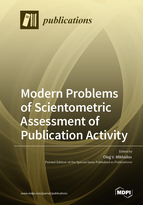Modern Problems of Scientometric Assessment of Publication Activity
A special issue of Publications (ISSN 2304-6775).
Deadline for manuscript submissions: closed (20 April 2022) | Viewed by 26009
Special Issue Editor
Interests: coordination chemistry; quantum chemistry; chemistry of macrocyclic compounds; nanosciences; scientometrics
Special Issues, Collections and Topics in MDPI journals
Special Issue Information
Dear Colleagues,
As is known, an objective assessment of scientific activity—both of an individual scientist and of scientific teams—is one of its most difficult problems, concerning the relationship within itself as well as with society. However, for many decades, the significance of scientists’ contribution to the development of the corresponding branch of science was assessed by the scientific community only by meaningful qualitative criteria, wherein the principle and mechanism of such an assessment was actually intuitive and defied quantitative description. That is why the urgent task was to create a system for evaluating scientific activity based on some objective indicators of this activity of a particular scientist; in search of those, in the 1970s–1980s, the term “citation index” appeared. Initially, in essence, it was a simple number of references to all the works of a given researcher, performed by them in the relevant branch of scientific activity for a specific time period. Although a close examination of this indicator revealed its limitations and in a number of cases even inadequacy in assessing scientific activity, it has nevertheless since the 1990s gained very wide popularity in the scientific community. This has contributed to the emergence of numerous works aimed at finding new, perfect indicators for assessing publication activity (so-called bibliometric indices); to date, several dozen such indices have been proposed, the most significant of which was the so-called Hirsch index or h-index. Nevertheless, despite the incredibly significant advances in this specific area of sociology, the above problem is still far from its resolution.
Research problem considered in this Special Issue: Despite the significant advances in this specific area of sociology, the problem of an adequate and objective assessment of scientific activity and publication activity is still far from being solved. In this regard, the key task of this Special Issue will be to familiarize its readers with the latest achievements both in the search for new, more advanced bibliometric indicators and in the improvement of existing ones.
In connection with the above, this thematic Special Issue will include mainly original full articles and short messages devoted to the problems of improving the quantitative assessment of scientific and publication activity of researchers and research teams using various bibliometric indices (both new original ones and those already proposed earlier). Articles are also welcome, in which there will be proposals for the development and improvement of indices characterizing the authority of scientific periodicals (journals). By prior agreement with the Editorial Office, comprehensive reviews on the above problems where the emphasis should be on the work of researchers who are not the review authors or their co-authors can also be submitted for publication in this Special Issue.
Prof. Dr. Oleg V. Mikhailov
Guest Editor
Manuscript Submission Information
Manuscripts should be submitted online at www.mdpi.com by registering and logging in to this website. Once you are registered, click here to go to the submission form. Manuscripts can be submitted until the deadline. All submissions that pass pre-check are peer-reviewed. Accepted papers will be published continuously in the journal (as soon as accepted) and will be listed together on the special issue website. Research articles, review articles as well as short communications are invited. For planned papers, a title and short abstract (about 100 words) can be sent to the Editorial Office for announcement on this website.
Submitted manuscripts should not have been published previously, nor be under consideration for publication elsewhere (except conference proceedings papers). All manuscripts are thoroughly refereed through a single-blind peer-review process. A guide for authors and other relevant information for submission of manuscripts is available on the Instructions for Authors page. Publications is an international peer-reviewed open access quarterly journal published by MDPI.
Please visit the Instructions for Authors page before submitting a manuscript. The Article Processing Charge (APC) for publication in this open access journal is 1400 CHF (Swiss Francs). Submitted papers should be well formatted and use good English. Authors may use MDPI's English editing service prior to publication or during author revisions.
Keywords
- scientometrics
- scientometric assessment
- scholarly publications
- scientific activity
- bibliometric parameter
- Hirsch Index






